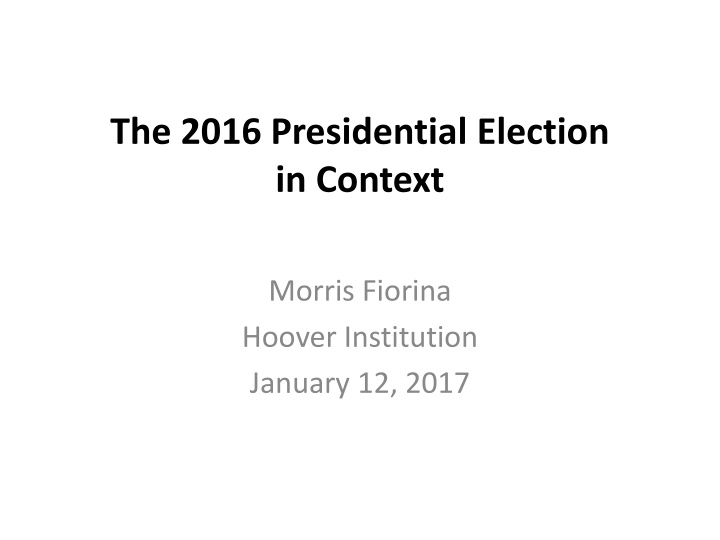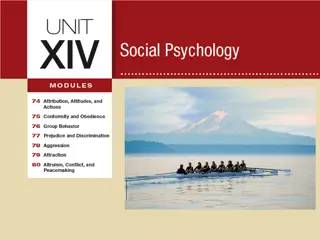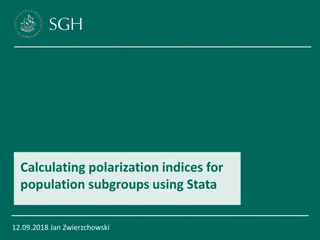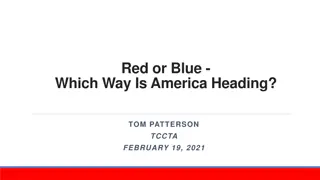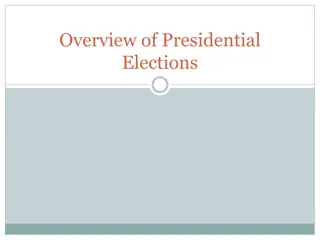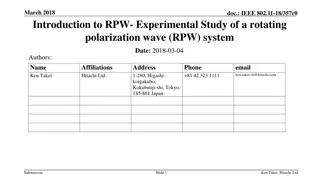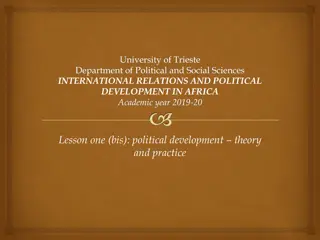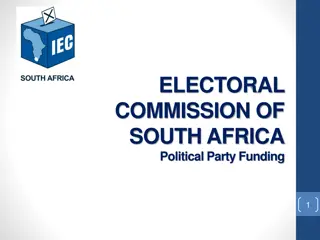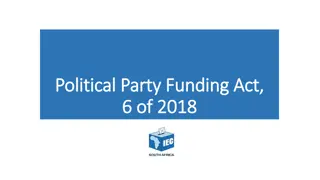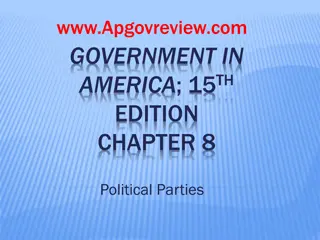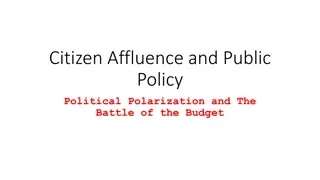Trends in U.S. Political Landscape: Polarization and Party Dynamics
The analysis delves into the evolution of the U.S. political scene, highlighting shifts in party majorities, polarization among liberals and conservatives, maintenance of moderate factions, the significance of independents, and the dominance of centrist issues. It explores the challenges posed by the polarization akin to European-style party ideologies within the U.S. system, which primarily operates with a two-party setup.
Download Presentation

Please find below an Image/Link to download the presentation.
The content on the website is provided AS IS for your information and personal use only. It may not be sold, licensed, or shared on other websites without obtaining consent from the author.If you encounter any issues during the download, it is possible that the publisher has removed the file from their server.
You are allowed to download the files provided on this website for personal or commercial use, subject to the condition that they are used lawfully. All files are the property of their respective owners.
The content on the website is provided AS IS for your information and personal use only. It may not be sold, licensed, or shared on other websites without obtaining consent from the author.
E N D
Presentation Transcript
The 2016 Presidential Election in Context Morris Fiorina Hoover Institution January 12, 2017
An Era of Unstable Majorities President House Senate 1992 D D D 1994 D R R 1996 D R R 1998 D R R 2000 D/R R Tie 2002 R R R 2004 R R R 2006 R D D 2008 D D D 2010 D R D 2012 D R D 2014 D R R 2016 D/R R R
WHY? The U.S. Political Parties Have Become More Like the Ideological Parties of 20thCentury Europe
Polarization Time 1 Time 2 33 Libs 50 Libs 34 Mods 0 Mods 34 Conservs 50 Conservs Time 1 Time 2 33 Dems 50 Dems 34 Inds 0 Inds 33 Reps 50 Reps
No Decline in Moderates 100 90 80 70 60 Percent 50 40 30 20 10 0 1974 1976 1978 1980 1982 1984 1986 1988 1990 1992 1994 1996 1998 2000 2002 2004 2006 2008 2010 2012 Liberal Moderate Conservative Source: GSS
No Decline in Independents 100 90 80 70 60 Percent 50 40 30 20 10 0 1952 1956 1960 1964 1968 1972 1976 1980 1984 1988 1992 1996 2000 2004 2008 2012 Strong and Weak Democrats Indepedents including Leaners Strong and Weak Republicans Source: ANES
Issue Centrists Still Dominate: 2012 50 45 40 35 Services/Spending Insurance 30 Percent Aid to Minorities 25 Jobs/SOL 20 Military Spending 15 10 5 0 1 2 3 4 5 6 7 Source: ANES * Haven t thought much about it responses recoded as moderates
Sorting Partisan Polarization L ________________________________ R -1 -.25 0 .25 +1 L __________________________________________ R -1 -.75 0 .75 +1
The Problem with European-Style Parties in the United States: Only two of them
Most Advanced Democracies Have Multi- Party Coalition Governments # of Parties in Govern # of Parties With Seats Australia Austria Belgium Czech Republic Finland France Germany Ireland Italy Japan Luxembourg Netherlands Sweden United Kingdom 4 2 4 3 4 4 3 2 6 5 3 2 2 1 9 10 12 7 10 17 5 10 10 12 6 12 8 10
Two Sizes Fit All? Platform 1 2 3 4 5 6 7 8 Foreign C C C C A A A A Economic G G M M G G M M Cultural P T P T P T P T (D) (ND) (R) (L)
Two Sizes Fit All? Platform 1 2 3 4 5 6 7 8 Foreign C C C C A A A A Economic G G M M G G M M Cultural P T P T P T P T (D) (R) (T?) (T?) (T?)
Do Any of the Parties Represent Your Views Reasonably Well? (YouGov/Polimetrix 2015) Strong Republicans 93 Weak Republicans 63 Independent Republicans 50 Independent Independents 11 Independent Democrats 40 Weak Democrats 46 Strong Democrats 87 0 20 40 60 80 100 % Answering Affirmative
Unstable Majorities Ideological parties in the U.S. context overreach attempt to implement base priorities alienates marginal supporters electoral reaction
Marginal Members of an Electoral Majority? (PEW Research Center) 50 45 % of Americans who say they are... 40 35 30 25 20 15 10 5 0 1988 1990 1992 1994 1996 1998 2000 2002 2004 2006 2008 2010 2012 2014 Republicans Independents Democrats
How Independents Vote in Presidential Elections 100 90 80 Supporting the Winning Candidate % Two-Party Presidential Vote 70 60 50 40 30 20 10 0 1952 1956 1960 1964 1968 1972 1976 1980 1984 1988 1992 1996 2000 2004 2008 2012
How Independents Vote in House Elections 30 20 % Republican - % Democrat 10 0 1976 1978 1980 1982 1984 1986 1988 1990 1992 1994 1996 1998 2000 2002 2004 2006 2008 2010 2012 2014 -10 -20 -30 Source: National Election Pool
Explaining the Trump Vote 1. Racism, misogyny, xenophobia
For anyone who voted for Donald Trump, bald-faced racism and sexism were not the deal-breakers they should have been. Hatred of women was on the ballot in November, and it won. (emphasis in original) Donald Trump has won the presidency, despite an unprecedented level of unfitness and in defiance of nearly every prediction and poll. And he s done this not despite (sic) but because he expressed unfiltered disdain toward racial and religious minorities in the country. Broder: Dark Age? Get a Grip People (2004)
The Day the Enlightenment Went Out Where else [but in the red states] do we find fundamentalist zeal, a rage at secularity, religious intolerance, fear of and hatred for modernity? We find it in the Muslim world, in Al Qaeda, in Saddam Hussein s Sunni loyalists. (Gary Wills) We re entering another dark age, more creationist than cutting edge, more pre- modern than postmodern. (Maureen Dowd)
Some Perspective Clinton carried PA, MI, WI by about 83,000 votes (.0006% of national vote) Change half, properly distributed, giving her a comfortable EC majority, and Americans Reject Racism, Sexism!
Preliminary Racism? Obama approval rating Aggregate election returns Sexism? Does Trumps treatment of women bother you? Yes: 63 % A lot: 50% (Clintonism?)
Explaining the Trump Vote 1. Racism, misogyny, xenophobia 2. General discontent (eg. Economic) 3. Specific issues (eg. Immigration) 4. Anti-elitism Economic (eg. Wall Street) Political (eg. The Democratic Party) Cultural (eg. Deplorables ) Media
Start with Hillary Clinton Donald Trump and Hillary Clinton head into the final hours of the 2016 presidential campaign with the worst election-eve images of any major-party presidential candidates Gallup has measured back to 1956.
Voted for Trump in Spite of TrumpHRC Favorable Opinion 38 % 43 Qualified 38 52 Honest and Trustworthy 33 36 Right Temperament 35 55 Bring Needed Change 83 14
Beyond the U.S. 2015 UK General Elections Brexit Trump Populist ( Far Right ) Resurgence
Support for Populist Parties in Western European Democracies Swiss People s Party Freedom Party of Austria New Flemish Alliance Progress Party (Norway) National Front (France) Sweden Democrats United Kingdom Independence Party Danish People s Party Party for Freedom (Netherlands) 26.6% 20.5 20.3 16.3 13.6 12.9 12.6 12.3 10.1 *Popular vote in most recent national election Source: List of Active Nationalist Parties in Europe. Wikipedia. http://en.wikipedia.org/wiki/List_of_active_nationalist_parties_in_Europe
Historical Similarities Globalization Economic Transformation Population Movement Mass Immigration Rising Inequality
The End Thank you!
When Should Abortion Be Permitted? Always as a Matter of Personal Choice 100 90 80 70 PID Differences 60 50 40 30 20 10 0 1980 1984 1988 1992 1996 2000 2004 2008 2012 Weak Partisans Stong Partisans Donors or Workers Source: ANES. Workers are strong and weak partisans who worked for a party or candidate. Donors are strong and weak partisans who donated to a party or candidate,
The Re-Nationalization of American Elections 1930s-1980s vote for the person, not the party 1990s-today vote for the party, not the person Decline in ticket splitting
Split Ticket (President/House) Voting Has Declined in Recent Decdes 50 45 % Splitting Presidential and Congressional Vote 40 35 30 25 20 15 10 5 0 1952 1956 1960 1964 1968 1972 1976 1980 1984 1988 1992 1996 2000 2004 2008 2012 Source: ANES. 2012 data FTF only.
When Should Abortion Be Permitted? (2012 ANES) Strong Democrats Strong Republicans Never permitted 9% 21% Only in case of rape, incest, or the woman's life is in danger 17 40 For a clear need 14 18 Always as a personal choice 60 22 Source: ANES, 2012 FTF Only
Electoral Chaos 1992: Ross Perot--19% / Clinton 43% (1912) 1994: Democrats 40 year reign in the House ends 1996: Democratic President / Republican Congress ! 1998: President s party gains seats in the House! 2000: Total Mess 2002: President s party gains seats again! 2004: Consolidation of the Reagan Revolution? 2006: No--Republican thumpin 2008: Resurrection of The New Deal? 2010: No--Democratic shellacking I 2012: Status quo, but Obama 2014: Democratic shellacking II 2016: Trump
Presidential Forecasting Models Erikson (economic indicators/polls 52.0 D (82%) & Wlezien Lockerbie (economic expectations/ 50.4 D (62%) 1st term Lewis-Beck (Approval/growth) &Tien 51.1 D (83%) Campbell (convention/growth) 51.2 D (75%) Abramowitz (Approval/growth/ 48.6 D (66%) 1st term) Norpoth (primaries) 47.5 D (87%)
